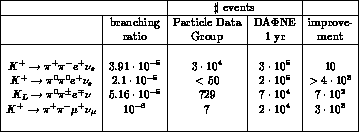
Table 5.1: Rates of
 decays [3]. The data
for
decays [3]. The data
for  is from ref.
[60].
is from ref.
[60].

Table 5.1: Rates of  decays [3]. The data
for
decays [3]. The data
for  is from ref.
[60].
is from ref.
[60].
We display in table 5.1 the number of events collected
so far.
The data are obviously dominated by the work of Rosselet et al.
[53], which measures the  final state with
good statistics. The authors parametrize the form factors as
final state with
good statistics. The authors parametrize the form factors as
with  and h assumed to be real
and h assumed to be real
![]() .
Furthermore, they put
.
Furthermore, they put  , such that
the form factors R and
, such that
the form factors R and  drop out in the decay distribution.
Despite the good statistics, the experiment has not been able to
separate out the full kinematic behaviour of the matrix
elements. Therefore certain approximations/assumptions had to
be made. For example, no dependence on
drop out in the decay distribution.
Despite the good statistics, the experiment has not been able to
separate out the full kinematic behaviour of the matrix
elements. Therefore certain approximations/assumptions had to
be made. For example, no dependence on  was seen within the
limits of the data, so that the results were quoted assuming
that such a dependence is absent. Similarly,
was seen within the
limits of the data, so that the results were quoted assuming
that such a dependence is absent. Similarly,  was found to
be compatible with zero, and hence put equal to zero when the
final result for g was derived. A dependence on
was found to
be compatible with zero, and hence put equal to zero when the
final result for g was derived. A dependence on  was
seen, and found to be compatible with
was
seen, and found to be compatible with
with
These approximations to the form factors do not agree completely
with what is found in the theoretical predictions. Dependence on
 and non-zero values for higher partial waves all occur in
the theoretical results.
and non-zero values for higher partial waves all occur in
the theoretical results.
The experimental results for the threshold values and the slopes of the form factors are [53]
We have used [3]  in
transcribing these results. (We note that from Eqs. (5.34 - 5.37)
and
in
transcribing these results. (We note that from Eqs. (5.34 - 5.37)
and  we
obtain
we
obtain  sec
sec . This value
must
be compared with
. This value
must
be compared with  sec
sec obtained in the same experiment.) In addition to the threshold
values (5.37) of the form factors, the phase shift difference
obtained in the same experiment.) In addition to the threshold
values (5.37) of the form factors, the phase shift difference
 was determined [53] in
five energy bins. The S-wave scattering length
was determined [53] in
five energy bins. The S-wave scattering length  was then
extracted by using a model of Basdevant, Froggatt and Petersen
[58]. This model is based on solutions to Roy
equations. The result for the scattering length is
was then
extracted by using a model of Basdevant, Froggatt and Petersen
[58]. This model is based on solutions to Roy
equations. The result for the scattering length is
A study by [59], based on a more recent solution to Roy equations, gives
Turning now to the  channel, we
consider the following recent data (based on
channel, we
consider the following recent data (based on  events) [60]:
events) [60]:
The group also measured the G form factor. Defining

they find

The slope agrees within the errors with the value (5.37) found by Rosselet et al. [53]. To compare the value of the form factor at threshold, we use the isospin prediction

which is not incompatible with  in eq. (5.37).
(Here
we have used
in eq. (5.37).
(Here
we have used
 to transcribe the data. Furthermore, we assume that the form
factor
to transcribe the data. Furthermore, we assume that the form
factor  measured in Ref. [60] indeed has to be divided by
measured in Ref. [60] indeed has to be divided by
 for the comparison with [53]. This is not quite clear to
us reading [60].)
for the comparison with [53]. This is not quite clear to
us reading [60].)
Finally for the channel  , we consider the
rate [3]
, we consider the
rate [3]
The kinematic dependence of the form factors on
the variables  and
and  has not yet been resolved
experimentally in this decay. In order to proceed, we assume that the
form factors in this channel are independent of
has not yet been resolved
experimentally in this decay. In order to proceed, we assume that the
form factors in this channel are independent of  , e.g.,
, e.g.,
 etc.
As a result of this assumption,
etc.
As a result of this assumption,  and
and  vanish
by Bose statistics. The contribution from
vanish
by Bose statistics. The contribution from  is completely
negligible in the electron mode, and the contribution from the anomaly form
factor to the decay (5.44) is tiny. We neglect it altogether,
as a result of which the above decay is fully determined by
is completely
negligible in the electron mode, and the contribution from the anomaly form
factor to the decay (5.44) is tiny. We neglect it altogether,
as a result of which the above decay is fully determined by  . We write
. We write
and obtain for the rate
This finally gives with


which compares very well with the isospin prediction
